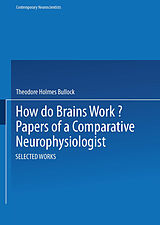How do Brains Work?
Einband:
E-Book (pdf)
EAN:
9781468494273
Autor:
Bullock
Herausgeber:
Birkhäuser Boston
Erscheinungsdatum:
29.06.2013
"I'll bet it will tum out that brains use both mechanisms, in different centers. " Much of my waking life and that of many of my friends is spent racking our brains over how brains work. This book claims that good science is often a form of betting on the outcome of research-the stakes being time and reputation and someone's money. Some scientists, to be sure, claim they avoid leaning this way or that, in the name of keeping an open mind. I recommend making expectations explicit in order to design controls against unconscious influence, formulate alternative outcomes more clearly-and to add zest. Both the immediately upcoming experiment and the expected result of many long years of work by many people after one is gone are proper subjects for betting or the most informed and serious guessing. The working title for this collection of new and old papers was for some time "Betting on how brains work" and then "Betting on brains. " It goes without saying that the book will not answer the title question but will speak to it, in particular making a series of propositions that I think are more likely to be confirmed by future research than the alternatives we can presently recognize. It follows that a significant message, implied in many chapters of the book is this.
Inhalt
1 Goals and Strategies in Brain Research: The Place of Comparative Neurology.- I Integration in the Neurons.- 2 Mechanisms of Integration: What Parameters Control Output as Function of Input?.- 3 Graded Signals: Is the All-Or-None Law Exceptional? Why Spikes?.- 4 Codes in the Neurons: How is Information Represented in Brain Tissue?.- 5 Reliability and Redundancy of Neurons: Can We Distinguish Probabilistic, Stochastic, and Noisy Processes?.- [46-2] A preparation for the physiological study of the unit synapse.- [56-6] Measurement of imposed voltage gradient adequate to modulate neuronal firing.- [57-4] Intracellular recording from the giant synapse of the squid.- [57-5] Diverse forms of activity in the somata of spontaneous and integrating ganglion cells.- [59-1] Neuron doctrine and electrophysiology.- [60-1] Modulation of activity of one neuron by subthreshold slow potentials in another in lobster cardiac ganglion.- [64-4] Pacemaker neurons: Effects of regularly spaced synaptic input.- 6 Circuitry and Beyond: How Far Does Connectivity Get Us?.- 7 Equivalence Sets: How Many Kinds of Nerve Cells Are There?.- II Transduction and Reception as Models of Brain Mechanisms.- [52-3] Physiology of an infrared receptor: The facial pit of pit vipers.- [61-4] Evidence for a category of electroreceptors in the lateral line of gymnotid fishes.- [65-5] Further analysis of sensory coding in electroreceptors of electric fish.- [73-2] Coding properties of two classes of afferent nerve fibers: High-frequency electroreceptors in the electric fish.- [74-2] An essay on the discovery of sensory receptors and the assignment of their functions together with an introduction to electroreceptors.- [89-4] Lateral line research: Prospects and opportunities.- III Central Systems and Higher Level Integration.- 8 Recognition: Are There Multiple Mechanisms for Filtering Complex Stimuli?.- 9 Expectation: Is Stimulus-Specific Apparent Anticipation a Sign of Higher Function?.- [64-3] Functional organization of receptive fields of move- ment detecting neurons in the frog's retina.- [67-2] Discrimination among temporal patterns of stimulation in a computer model of a coelenterate nerve net.- [77-6] Neuronal mechanisms for object discrimination in the weakly electric fish Eigenmannia virescens.- [82-9] The sensory functions of the cerebellum of the thornback ray, Platyrhinoidis triseriata.- [84-13] Cerebellum mediates modality-specific modulation of sensory responses of midbrain and forebrain in rat.- [89-3] Physiology of lateral line mechanoreceptive regions in the elasmobranch brain.- IV Compound Field Potentials.- 10 Brain Waves: Is Synchrony a Sign of Higher Function? Is the EEG Basically Rhythmic?.- [45-2] Problems in the comparative study of brain waves.- [83-4] Electrical signs of activity in assemblies of neurons: Compound field potentials as objects of study in their own right.- [88-4] Comparison of ongoing compound field potentials in the brains of invertebrates and vertebrates.- [89-8] Lateral coherence of the electrocorticogram: A new measure of brain synchrony.- 11 Evoked and Event-Related Potentials: Has Evolution Altered Assembly Responses?.- [72-2] Evoked potentials in the central auditory system of alert porpoises to their own and artificial sounds.- [79-5] Acoustic evoked activity in the brain in sharks.- [81-7] Auditory brainstem response in dolphins.- [81-6] Neuroethology deserves more study of evoked responses.- [82-6] Auditory brainstem response in five vertebrate classes.- V Neuroethology and the Evolution of Brain and Behavior.- 12 Neuroethology: What Does It Mean for General Neurobiology?.- [61-1] The origins of patterned discharge.- [72-5] The jamming avoidance response of high frequency electric fish. II. Quantitative aspects.- [83-5] Neuroethological role of dynamic traits of excitable cells: A proposal for the physiological basis of slothfulness in the sloth.- [86-7] Significance of findings on electroreception for general neurobiology.- 13 Evolution of the Nervous System: What's So Special About Brains?.- [83-7] The phylogenetic distribution of electroreception: Evidence for convergent evolution of a primitive vertebrate sense modality.- [84-6] Comparative neuroscience holds promise for quiet revolutions.- [86-6] 'Simple' model systems need comparative studies: Differences are as important as commonalities.- 14 Comparative Cognition: What Measures of Capacities Can Apply to Diverse Species?.- [82-2] Afterthoughts on animal minds.- [84-8] The application of scientific evidence to the issues of use of animals in research: The evolutionary dimension in the problem of animal awareness.- Bibliography of Theodore Holmes Bullock.- Bibliography of Associates.- Permissions.

Leider konnten wir für diesen Artikel keine Preise ermitteln ...
billigbuch.ch sucht jetzt für Sie die besten Angebote ...
Die aktuellen Verkaufspreise von 6 Onlineshops werden in Realtime abgefragt.
Sie können das gewünschte Produkt anschliessend direkt beim Anbieter Ihrer Wahl bestellen.
Loading...
Die aktuellen Verkaufspreise von 6 Onlineshops werden in Realtime abgefragt.
Sie können das gewünschte Produkt anschliessend direkt beim Anbieter Ihrer Wahl bestellen.
| # | Onlineshop | Preis CHF | Versand CHF | Total CHF | ||
|---|---|---|---|---|---|---|
| 1 | Seller | 0.00 | 0.00 | 0.00 |
